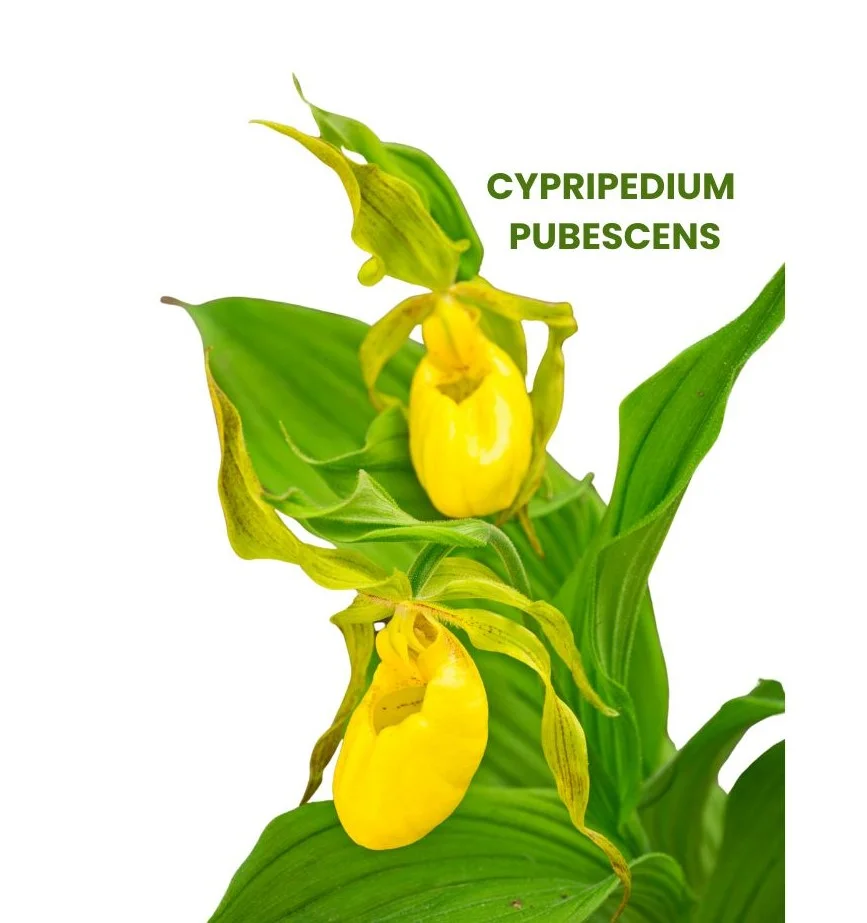Cypripedium pubescens, commonly known as Yellow Lady’s Slipper, is a species of orchid native to North America.
In homeopathy, it is primarily used to treat various nervous disorders, debility, sleeplessness, and skin symptoms resembling those of Rhus poisoning.

Table of Contents
ToggleSOURCE INFORMATION
Cypripedium pubescens is prepared from the fresh root of the orchid plant through the process of maceration and potentization according to homeopathic principles.
Scientific Classification
- Kingdom: Plantae
- Order: Asparagales
- Family: Orchidaceae
- Genus: Cypripedium
- Species: Cypripedium pubescens
Origin
- Cypripedium pubescens is native to North America, where it can be found growing in various habitats such as woodlands, meadows, and slopes.
- It is particularly prevalent in regions across the continent, including parts of the United States and Canada.
Historical Facts
- The genus Cypripedium, to which Cypripedium pubescens belongs, comprises over 50 species of orchids commonly known as “Lady’s Slippers.”
- These orchids are characterized by their slipper-shaped pouch-like flowers, which have earned them their common name.
- Cypripedium pubescens has been historically recognized for its ornamental value, with its striking yellow flowers making it a sought-after plant for gardeners and enthusiasts.
- In addition to its ornamental use, Cypripedium pubescens has a history of traditional medicinal use among Native American tribes.
- It was used for various purposes, including treating nervous disorders and promoting relaxation.
- In modern times, Cypripedium pubescens is also valued in homeopathy, where it is prepared as a remedy to address nervousness, sleep disturbances, and other nervous system-related conditions, particularly in children and the elderly.
Overall, Cypripedium pubescens is a fascinating plant with both historical significance and therapeutic value in traditional and homeopathic medicine.
DRUG PATHOGENESIS
- Acts primarily on the nervous system, alleviating nervousness, and hyperesthesia.
- Useful in cases of debility following gout and hydrocephaloid symptoms resulting from prolonged diarrhoea.
KEY CHARACTERISTICS
- Addresses nervousness in children, often associated with teething and intestinal troubles.
- Indicated for debility following gout and hydrocephaloid symptoms due to prolonged diarrhoea.
- Effective in relieving sleeplessness and cerebral hyperesthesia in young children.
PARTICULAR ORGAN SYMPTOMS
HEAD SYMPTOMS
- In children, there may be nocturnal crying, wakefulness, and playful behavior, indicating nervousness and restlessness.
- Elderly individuals and those going through climacteric stages may experience headaches, which could be dull or throbbing in nature.
SKIN SYMPTOMS
- Symptoms resemble those of poisoning caused by Rhus toxicodendron, such as skin redness, swelling, itching, and blistering.
- Cypripedium pubescens acts as an efficient antidote to alleviate skin symptoms associated with Rhus poisoning.
MODALITIES
- Symptoms worsen at night.
- Symptoms may be aggravated by overstimulation of the brain.
WHAT ARE MODALITIES IN HOMOEOPATHY?
RELATIONSHIP WITH OTHER DRUGS
- Comparable to Ambra, Kali bromatum, Scutellaria, Valeriana, and Ignatia.
- Skin-related comparisons include Grindelia and Anacardium.
DOSE
- Tincture to sixth attenuation.
- For Poison Oak, 5 drops of tincture per dose, also applied locally.
Frequently Asked Questions
What is Cypripedium pubescens commonly known as?
- Cypripedium pubescens is commonly known as Yellow Lady’s Slipper.
What is the origin of Cypripedium pubescens?
- Cypripedium pubescens is native to North America, where it grows in various habitats such as woodlands, meadows, and slopes.
What is the historical significance of Cypripedium pubescens?
- The genus Cypripedium, to which Cypripedium pubescens belongs, comprises over 50 species of orchids known as “Lady’s Slippers.”
- It has been historically valued for its ornamental beauty and traditional medicinal uses among Native American tribes.
What are the key characteristics of Cypripedium pubescens in homeopathy?
- Cypripedium pubescens primarily addresses nervous disorders, debility following gout, sleeplessness, and skin symptoms resembling those of Rhus poisoning.
How does Cypripedium pubescens affect particular organ symptoms?
- In children, it alleviates nervousness, teething-related issues, and sleep disturbances.
- In the elderly, it helps with headaches during climacteric stages.
- For skin symptoms, it acts as an efficient antidote to Rhus poisoning.
What are the modalities associated with Cypripedium pubescens?
- Symptoms may worsen at night and can be aggravated by overstimulation of the brain.
What is the relationship of Cypripedium pubescens with other drugs?
- It is comparable to Ambra, Kali bromatum, Scutellaria, Valeriana, and Ignatia.
- For skin-related issues, comparisons include Grindelia and Anacardium.
What is the recommended dose of Cypripedium pubescens?
- Cypripedium pubescens is typically taken as a tincture up to the sixth attenuation.
- For Poison Oak, 5 drops of tincture per dose can be applied locally.
Meaning of Difficult Words
- Debility: Weakness or lack of strength.
- Hydrocephaloid: Symptoms resembling those of hydrocephalus, a condition characterized by an abnormal accumulation of fluid in the brain.
- Hyperesthesia: Increased sensitivity to stimuli, such as touch or sound.
- Climacteric: The period of life, especially in women, when physiological changes associated with the end of reproductive capability occur, typically around menopause.
- Antidote: A substance that counteracts the effects of poison or relieves the symptoms of a particular condition.
